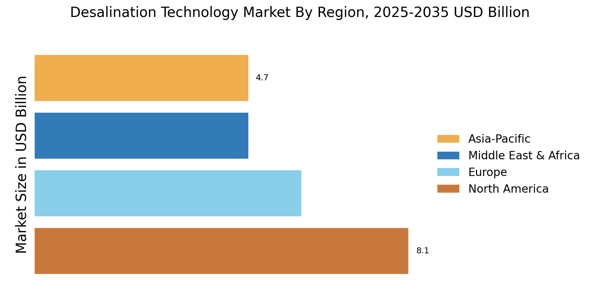Increasing Water Scarcity
The escalating issue of water scarcity is a primary driver for the Desalination Technology Market. As populations grow and climate change exacerbates drought conditions, the demand for alternative water sources intensifies. Reports indicate that by 2025, nearly 1.8 billion people will live in areas with absolute water scarcity, prompting governments and industries to seek innovative solutions. Desalination technology offers a viable means to convert seawater into potable water, thus addressing the urgent need for sustainable water supply. This trend is likely to propel investments in desalination plants, with the market projected to reach USD 30 billion by 2027. The increasing reliance on desalination underscores its critical role in ensuring water security in arid regions.
Technological Innovations
Technological advancements play a pivotal role in shaping the Desalination Technology Market. Innovations such as reverse osmosis, forward osmosis, and solar desalination are enhancing efficiency and reducing costs. For instance, the introduction of energy recovery devices has significantly lowered energy consumption in desalination processes. The market is witnessing a shift towards more energy-efficient systems, with some technologies achieving energy consumption rates as low as 1.5 kWh/m3. Furthermore, the integration of renewable energy sources, such as solar and wind, is expected to further reduce operational costs and environmental impact. As these technologies evolve, they are likely to attract more investments, thereby expanding the market and making desalination a more feasible option for water-scarce regions.
Rising Demand for Clean Water
The rising demand for clean water is a significant driver of the Desalination Technology Market. As urbanization accelerates and industrial activities expand, the pressure on existing freshwater resources intensifies. The World Health Organization estimates that by 2025, approximately 2.4 billion people will lack access to safe drinking water. This alarming statistic underscores the urgent need for alternative water sources, with desalination emerging as a key solution. The market is projected to grow as municipalities and industries invest in desalination plants to meet the increasing demand for potable water. Furthermore, the growing awareness of water quality issues is likely to drive the adoption of advanced desalination technologies, ensuring that the water produced meets stringent safety standards.
Government Initiatives and Funding
Government initiatives and funding are crucial drivers for the Desalination Technology Market. Many countries are recognizing the importance of desalination in their water management strategies and are allocating substantial budgets to support the development of desalination projects. For example, recent reports indicate that several nations have committed over USD 10 billion collectively to enhance their desalination infrastructure. These investments not only facilitate the construction of new plants but also promote research and development in desalination technologies. Additionally, favorable policies and incentives are being introduced to encourage private sector participation, which could further accelerate market growth. As governments prioritize water security, the role of desalination technology is expected to become increasingly prominent.
Environmental Concerns and Sustainability
Environmental concerns and sustainability are increasingly influencing the Desalination Technology Market. As awareness of the ecological impact of traditional water sourcing methods grows, there is a shift towards more sustainable practices. Desalination technology, particularly when powered by renewable energy, presents a more environmentally friendly alternative to groundwater extraction and surface water diversion. The market is witnessing a trend towards the development of eco-friendly desalination plants that minimize brine discharge and energy consumption. Reports suggest that sustainable desalination solutions could reduce the carbon footprint of water production by up to 50%. This focus on sustainability is likely to attract investments and drive innovation, positioning desalination as a critical component of future water management strategies.


















Leave a Comment